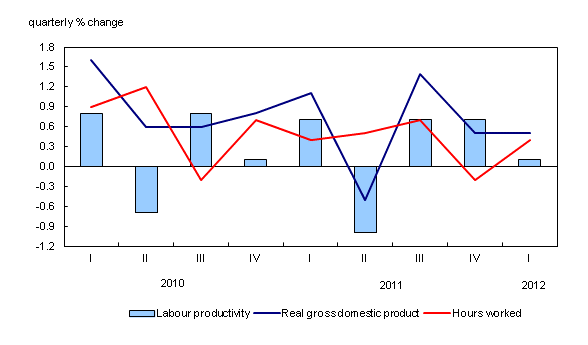Labour productivity, hourly compensation and unit labour cost, first quarter 2012
Archived Content
Information identified as archived is provided for reference, research or recordkeeping purposes. It is not subject to the Government of Canada Web Standards and has not been altered or updated since it was archived. Please "contact us" to request a format other than those available.
Related subjects
-
[an error occurred while processing this directive]
The labour productivity of Canadian businesses edged up 0.1% in the first quarter, after increasing 0.7% in each of the previous two quarters.
Real output of Canadian businesses and hours worked grow at a similar rate

Chart description: Real output of Canadian businesses and hours worked grow at a similar rate
The slight productivity gain in the first quarter reflected the recovery of hours worked after a quarter of decline, as businesses maintained the same rate of real output growth as in the previous quarter.
The growth of the real gross domestic product of businesses was 0.5% in the first quarter, the same as in the fourth quarter of 2011. Services-producing businesses were the main contributors to the increase in output, as activity intensified in wholesale trade. Output for goods-producing businesses was unchanged from the previous quarter.
Hours worked in businesses grew 0.4% in the first quarter, after falling 0.2% in the previous quarter. Most of the increase in hours worked was in the services sector (+0.6%), as hours worked edged up 0.1% in goods-producing businesses.
There was little variation in the productivity of goods-producing businesses and services-producing businesses in the first quarter.
Productivity in the goods-producing businesses (-0.1%) decreased slightly in the first quarter, following two quarterly advances of more than 1.0%. The productivity gains in manufacturing (+0.8%) and construction (+0.4%) were not enough to offset declines in mining and oil and gas extraction (-0.9%) and agriculture, forestry, fishing and hunting (-0.3%).
Productivity in services-producing businesses posted a modest 0.1% increase. Productivity increases in wholesale trade (+1.1%), transportation and warehousing (+0.6%) and administrative services (+1.9%) were partly offset by declines in the other industries.
In the United States, business productivity fell 0.2% in the first quarter, its first decrease in a year.
In Canadian businesses, labour costs per unit of production were up 0.4% in the first quarter, after rising 0.8% in the previous quarter.
The growth of average compensation per hour worked, which was 1.5% in the fourth quarter of 2011, slowed to 0.5% in the first quarter, outpacing the modest growth of productivity. It was the second successive quarter in which hourly compensation in Canada grew faster than productivity.
After two quarters of depreciation, the average value of the Canadian dollar relative to the American currency was up 2.3% in the first quarter. Because of the appreciation, Canadian businesses' unit labour costs measured in US dollars rose 2.6%, their first increase in three quarters.
By comparison, unit labour costs in American businesses increased 0.3% after declining in the previous quarter.
Note to readers
With this release, data were revised back to the first quarter of 2011.
Important changes are coming to Canada's System of National Accounts (CSNA), starting in October. These changes will affect all users of CSNA products and statistics such as gross domestic product (GDP), balance of payments, international investment, and input-output tables. For more information, consult the National Economic Accounts website. Because of the 2012 CSNA historical revision, the publication of the first quarter 2012 data includes revisions extending back only one year at the aggregate level.
The term "productivity" in this release refers to labour productivity. For the purposes of this analysis, labour productivity and related variables cover the business sector only. Labour productivity is a measure of real GDP per hour worked. Unit labour cost is defined as the cost of workers' wages and benefits per unit of real GDP.
All the growth rates reported in this release are rounded to one decimal place. They are calculated with index numbers rounded to three decimal places, which are now available on CANSIM.
Available without charge in CANSIM: tables CANSIM table383-0008 and CANSIM table383-0012.
Definitions, data sources and methods: survey number survey number5042.
Additional tables and links to other releases from the national accounts can be found in the first quarter 2012 issue of Canadian Economic Accounts Quarterly Review, Vol. 11, no. 1 (Catalogue number13-010-X, free), available from the Key resource module of our website under Publications. This publication will be updated on June 15, at the time of the release of the national balance sheet accounts.
Labour productivity, hourly compensation and unit labour cost data for the second quarter will be released on September 7.
For more information, or to order data, contact Statistics Canada's National Contact Centre (toll-free 1-800-263-1136; 613-951-8116; infostats@statcan.gc.ca).
To enquire about the concepts, methods or data quality of this release, contact Jean-Pierre Maynard (613-951-3654; jean-pierre.maynard@statcan.gc.ca), Income and Expenditure Accounts Division.
- Date modified:
